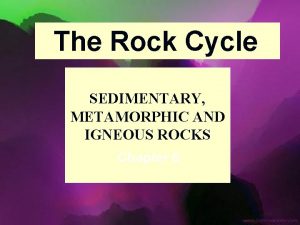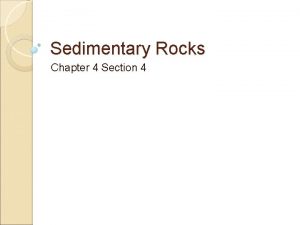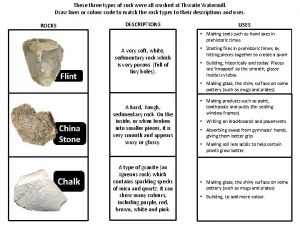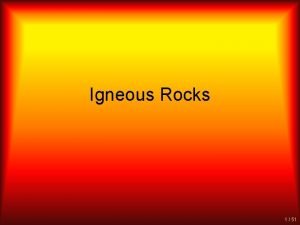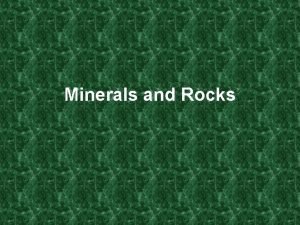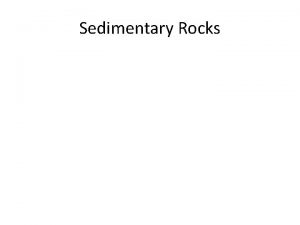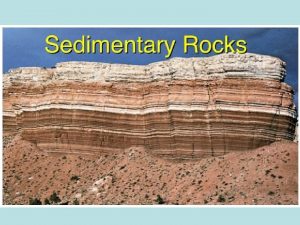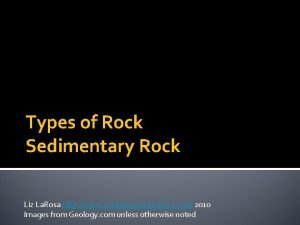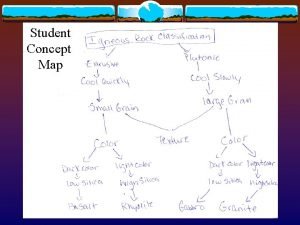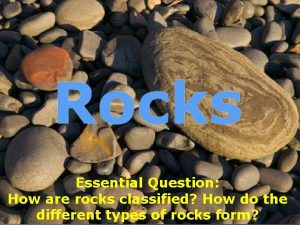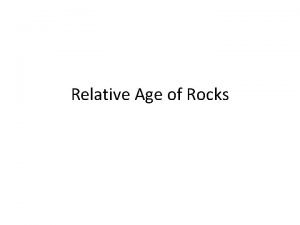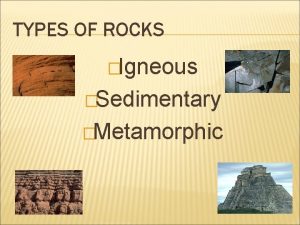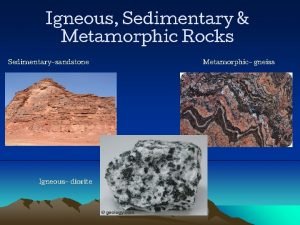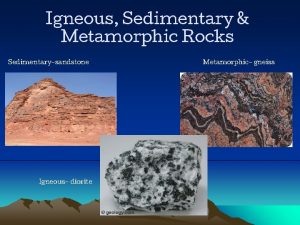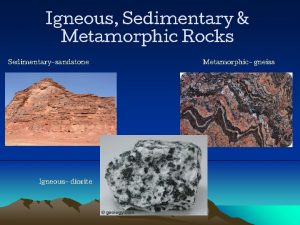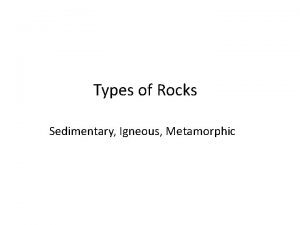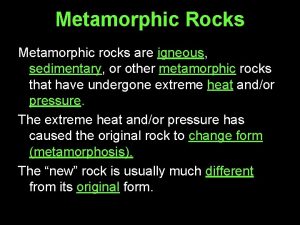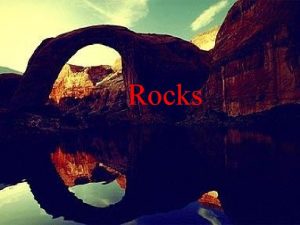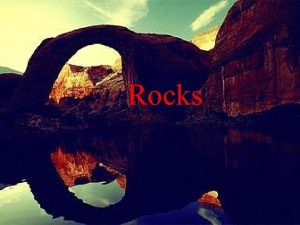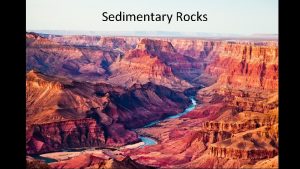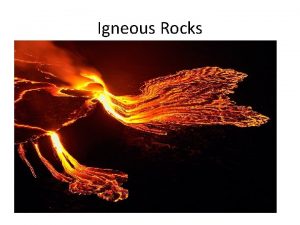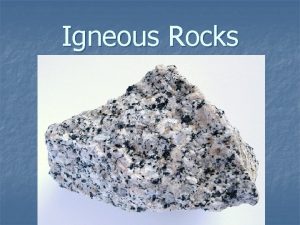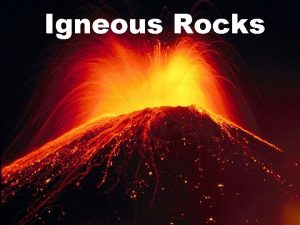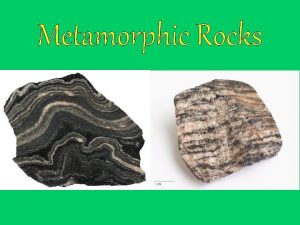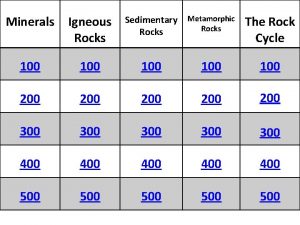Types of Rocks Sedimentary Igneous Metamorphic Sedimentary Rocks


























- Slides: 26

Types of Rocks Sedimentary, Igneous, Metamorphic

Sedimentary Rocks • Form when loose sediment (rocks, sand) is deposited by water, compacted, and cemented together. • Form as a chemical reaction in the water that leaves a chemical deposit, usually on an ocean bottom. • Form along beaches, by rivers, or under the water in lake or oceans.

Sedimentary Rocks

Sedimentary Rocks • Made up of smaller rocks cemented together • Sometimes have fossils • Usually have layers.

Examples of Sedimentary Rocks

Igneous Rocks • Some were once liquid magma that erupted from volcanoes. They cooled very quickly. (Extrusive) • Others were once liquid magma, but they did not erupt from volcanoes. Instead, they cooled slowly underground. (Intrusive)

Igneous Rocks • Extrusive: – Rocks that are from cooled lava (above ground. – They cooled very quickly, therefore formed small crystals • Intrusive – Rocks that are from cooled magma (below ground) – They cooled very slowly, therefore formed large crystals.

Igneous Rocks Intrusive Extrusive

Igneous Rocks

Examples of Igneous Rock

Metamorphic • Form when igneous, sedimentary, or other metamorphic rocks are heated and/or squished, forming a new rock type. • Usually has interlocking crystals and layers (called foliation)

Metamorphic • This can either happen underground or above ground. – Underground: high pressure and heat – Above ground: volcano erupting • When classifying metamorphic rocks, they always come from a parent rock.

The Rock Cycle weathering Metamorphic Sedimentary Igneous Rocks are weathered, eroded, transported, deposited, and lithified to form sedimentary rocks

Becoming a SEDIMENTARY ROCK The igneous rock granite can be physically weathered to produce clay and sand. These sediments can be transported deposited and lithified to form sedimentary rocks. Clay can become shale Sand can become sandstone.

Becoming a SEDIMENTARY ROCK The metamorphic rock gneiss can be physically weathered to produce clay and sand. These sediments can be transported deposited and lithified to form sedimentary rocks. Clay can become shale Sand can become sandstone.

Becoming a SEDIMENTARY ROCK Sedimentary rocks can be physically weathered to produce sediments that can become other sedimentary rocks.

Becoming a SEDIMENTARY ROCK H 2 O + CO 2 H 2 CO 3 Chemical weathering dissolves the minerals in rocks. The resulting dissolved compounds could form evaporites like rock salt or rock gypsum or chemical precipitates like some kinds of limestones. What forms depends upon composition and depositional environment factors. 2 KAl. Si 3 O 8+ 2 H+ + H 2 O Al 2 Si 2 O 5(OH)4+ 2 K+ + 4 Si. O 2

As the ice advances When the ice retreats, it can scour the bedrock sediments are deposited and move a lot of material. and new set of landforms exist.

Glacial deposits are much younger than the bedrock on which they are resting.

The Rock Cycle Metamorphic Sedimentary Igneous Rocks form from molten rock or magma in the subsurface or from lava extruded at the surface

Becoming an IGNEOUS ROCK Any existing rock – igneous, metamorphic or sedimentary - can be subjected to enough heat and or pressure causing it to melt. Molten rock is called magma. When magma cools to a solid it becomes an igneous rock. The kind of igneous rock formed depends on what was melted and how it cooled. Igneous rocks are classified based on their mineral composition and texture.

The Rock Cycle Metamorphic Sedimentary Igneous Pressure, heat and fluids cause preexisting rocks or sediments to become metamorphic rocks

Becoming a METAMORPHIC ROCK If the igneous rock basalt is exposed to sufficient heat and or pressure it can be transformed into the metamorphic rock call metabasalt When the prefix meta is applied to a rock name that means that the original rock has been metamorphosed.

Becoming a METAMORPHIC ROCK If the sedimentary rock limestone or dolomite is metamorphosed it can become the metamorphic rock marble. If the sedimentary rock sandstone is metamorphosed it can become the metamorphic rock quartzite. If the sedimentary rock shale is metamorphosed it can become the metamorphic rock slate.

Becoming a METAMORPHIC ROCK If the metamorphic rock slate is metam orphosed it can become the metamorphic rock phyllite If the metamorphic rock phyllite is metamorphosed it can become the metamorphic rock schist. If the metamorphic rock schist is metamorp hosed it can become the metamorphic rock gneiss.

The Rock Cycle weathering Metamorphic Sedimentary Igneous The Rock Cycle does not go in just one direction. Any given rock can go through any part of the cycle any number of times.
 Can igneous rocks form metamorphic rocks
Can igneous rocks form metamorphic rocks Compaction and cementation
Compaction and cementation Concept map of magma
Concept map of magma Marble cleavage
Marble cleavage Igneous sedimentary and metamorphic
Igneous sedimentary and metamorphic Lutonic
Lutonic Rock cycle song for kids
Rock cycle song for kids Rock cycle for kids
Rock cycle for kids Sedimentary igneous rocks
Sedimentary igneous rocks Grain size chart
Grain size chart Cementation sedimentary rocks
Cementation sedimentary rocks Sedimentary and metamorphic rocks chapter 6
Sedimentary and metamorphic rocks chapter 6 Sedimentary rocks turn into metamorphic
Sedimentary rocks turn into metamorphic Three types of rocks
Three types of rocks Elements look like
Elements look like Organic sedimentary rocks
Organic sedimentary rocks Siliceous rocks examples
Siliceous rocks examples Photo of sedimentary rock
Photo of sedimentary rock Types of sedimentary rocks
Types of sedimentary rocks How is magma formed
How is magma formed Metamorphic sedimentary
Metamorphic sedimentary Concept map for igneous rocks
Concept map for igneous rocks What is massive igneous rock
What is massive igneous rock Concept map for igneous rocks
Concept map for igneous rocks Rocks classified
Rocks classified How do you determine the relative age of igneous rocks
How do you determine the relative age of igneous rocks Igneous rocks
Igneous rocks






